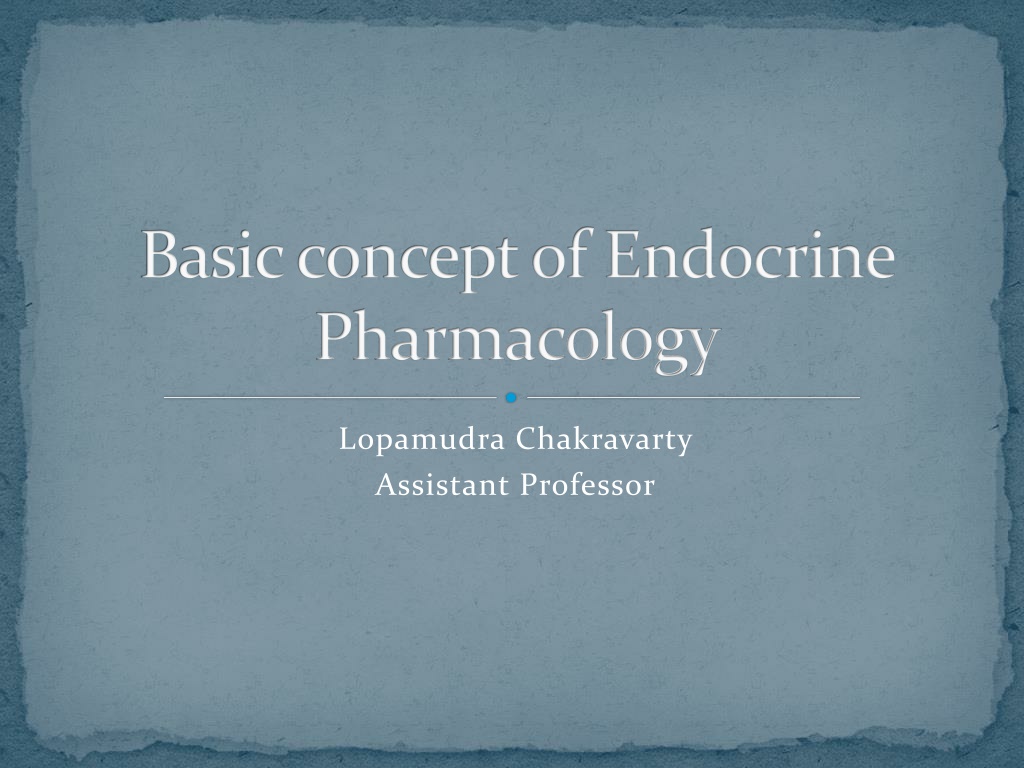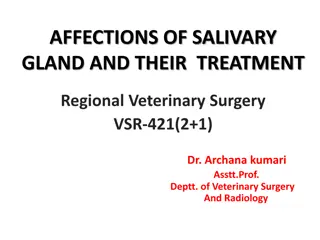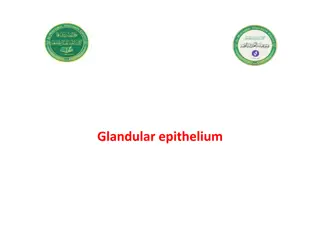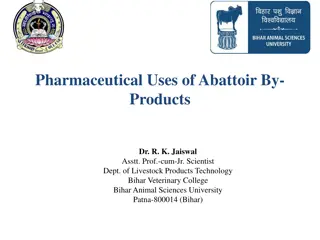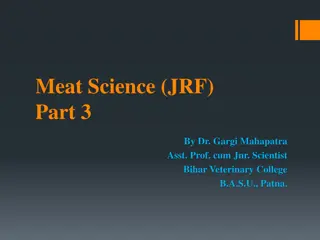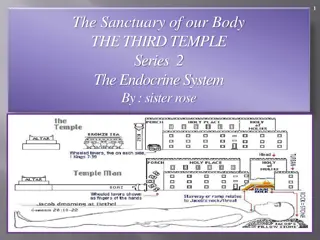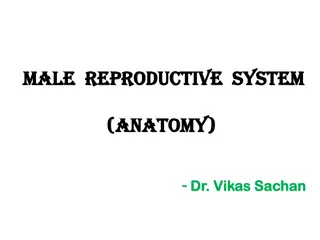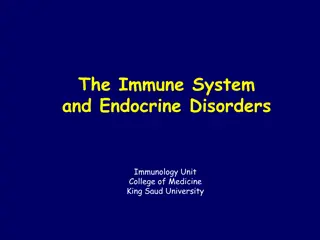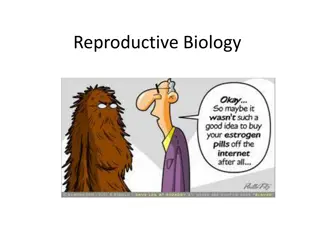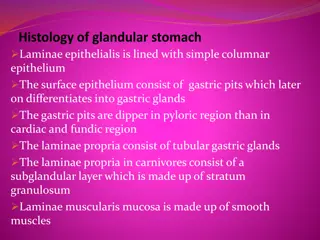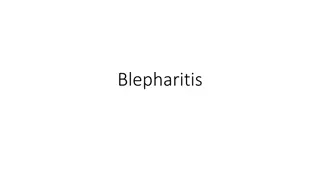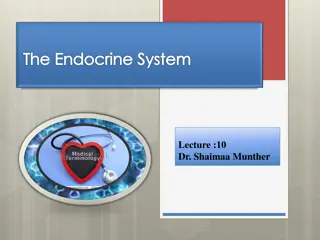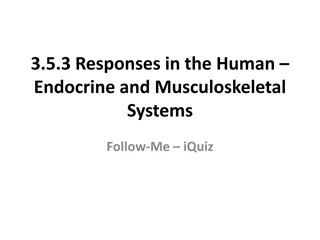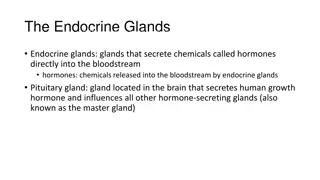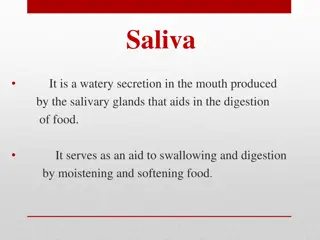Understanding Glands: Endocrine and Exocrine Systems
Glands play a crucial role in the body by producing and releasing substances for specific functions. Endocrine glands release hormones directly into the bloodstream, while exocrine glands secrete substances through ducts onto bodily surfaces. Different types of exocrine glands, such as sweat glands, sebaceous glands, and salivary glands, perform varied functions essential for maintaining bodily processes. Understanding the functions of endocrine and exocrine glands helps in comprehending the body's intricate systems.
Download Presentation

Please find below an Image/Link to download the presentation.
The content on the website is provided AS IS for your information and personal use only. It may not be sold, licensed, or shared on other websites without obtaining consent from the author. Download presentation by click this link. If you encounter any issues during the download, it is possible that the publisher has removed the file from their server.
E N D
Presentation Transcript
Basic concept of Endocrine Pharmacology Lopamudra Chakravarty Assistant Professor
What is a gland? A gland is an organ which produces and releases substances that perform a specific function in the body. There are two types of gland- Endocrine glands are ductless glands and release the substances that they make (hormones) directly into the bloodstream. Exocrine gland (e.g. sweat glands, lymph nodes). These are not considered part of the endocrine system as they do not produce hormones and they release their product through a duct. Information on these glands is not included on this website.
Exocrine Glands Exocrine glands secrete substances through ducts onto your bodily surfaces. Exocrine glands can be found in many different organs and have many different functions. Exocrine glands secrete sweat from your sweat glands, tears from your lacrymal glands, saliva from your salivary glands, milk from your mammary glands and more.
What are the different types of exocrine glands? Many organs in body use exocrine glands to function properly. Examples of exocrine glands include: Sweat glands: sweat glands create and secrete sweat. A type of sweat gland called eccrine sweat glands covers almost entire body surface. These sweat glands produce clear, non-oily sweat that helps control body temperature. Sebaceous glands: sebaceous glands are also on skin. But they open into hair follicles. Sebaceous glands secrete sebum. Sebum is an oily substance that lubricates and protects your hair and skin. Salivary glands: salivary glands create and secrete saliva. Salvia helps you chew, swallow and digest food. Lacrimal glands: lacrimal glands are tear glands. lacrimal glands are located above upper eyelids. They create and secrete a fluid that gets into eyes every time we blink. This fluid helps keep eyes moisturized. Mammary glands: mammary glands produce milk. milk is nutrient-rich and helps protect baby s developing immune system. Stomach glands: Glands in stomach release enzymes that help break down food. They also help body absorb important nutrients. Brunner glands: The Brunner glands are located in the first part of small intestine. This is called duodenum. The Brunner glands produce mucus that protects duodenum from stomach acid. They also help your body digest food and absorb nutrients. liverand pancreas are exocrine glands too. liver secretes bile through ducts into gastrointestinal tract. Pancreas secretes pancreatic juices through ducts into gastrointestinal tract
Endocrine gland An organ that makes hormones that are released directly into the blood and travel to tissues and organs all over the body. Endocrine glands help control many body functions, including growth and development, metabolism, and fertility. Some examples of endocrine glands are the pituitary, thyroid, and adrenal glands.
Difference Between Exocrine Glands and Endocrine Glands Endocrine Glands Exocrine Glands Ducts Endocrine glands do not have ducts Exocrine glands have ducts Secretory Products Hormones Sweat, enzymes, mucus, sebum Route of Secretion Secretoryproducts released directly into the bloodstream, eventually reaching the target organ. Secretory products are released to an internal organ or the external surface through a duct Examples Thyroid glands, parathyroid glands, pituitary glands, adrenal glands. Salivary glands, pancreas, liver, Brunner s glands, oesophagal glands
FEEDBACK CONTROL OF HORMONE SECRETION The endocrine system is controlled by complex feedback mechanisms in which the secretion of a hormone is turned on (stimulated) or turned off (inhibited), depending on its concentration. Such feedback mechanisms help the body maintain homeostasis. There are two types of feedback control mechanisms negative feedback and positive feedback.
NEGATIVE FEEDBACK Negative feedback helps to maintain homeostasis by keeping hormone levels within a narrow range. In a negative feedback mechanism, high levels of a hormone turn off further release of that hormone. This usually occurs in a stepwise pattern: the high concentration of the hormone signals back through the system to turn off production of the hormone or hormones that stimulated its release. The TRH-TSH-thyroxine system described in the section Hypothalamus is a classic example of negative feedback. High levels of thyroxine in the blood signal the hypothalamus to stop releasing TRH. Without TRH, the anterior pituitary stops producing TSH. Without TSH, the thyroid stops releasing thyroxine. When thyroxine levels drop below normal, the body signals the hypothalamus to turn on production of TRH. TRH signals the pituitary to release TSH, and TSH then stimulates the thyroid to produce thyroxine
POSITIVE FEEDBACK Positive feedback produces a response that continues to increase in order to produce the desired effect. In this mechanism, the activity of a hormone signals the system to produce and release more of the hormone. An example of a positive feedback mechanism is the release and response of oxytocin during childbirth. The first contractions of the uterus signal the body to release oxytocin. Oxytocin travels to the uterus, where it stimulates more contractions. The contractions signal back to the body to release more oxytocin, which stimulates more contractions, and so on. The feedback loop continues until the child is born the contractions stop, signaling the body to stop releasing oxytocin.
The major endocrine glands of mammals Hypothalamus Pituitary Pineal thyroid Parathyroids Thymus Pancreas Adrenals Gonads (ovaries and testes). Some nonendocrineorgans also make hormones; these include the stomach, small intestine, and kidneys. The placenta of pregnant mammals has an endocrine function (HCG). It produces hormones that influence uterine, fetal, and ovarian processes.
HYPOTHALAMUS The hypothalamus is a small structure located near the base of the brain that plays a key role in regulating many body processes. The hypothalamus affects the endocrine system primarily through control of the pituitary gland via production of releasing hormones. These messengers are so-named because they stimulate the release of hormones made in the pituitary. For example, thyrotropin-releasing hormone (TRH) is made and released by the hypothalamus. TRH travels to the pituitary, where it stimulates production of thyrotropin, or thyroid-stimulating hormone (TSH). TSH travels via the blood to the thyroid gland, where it stimulates production of the hormone thyroxine. This pathway can be summarized as follows: TRH[hypothalamus] TSH[anterior pituitary] thyroxine[thyroid gland] The hypothalamus also produces two hormones- vasopressin and oxytocin, that act directly on distant target organs. Vasopressin, also called antidiuretic hormone (ADH), helps the body conserve water. Oxytocin is critical during and after childbirth. It causes muscle contractions in the uterus and stimulates milk flow from the mother s breasts. Though produced by the hypothalamus, both hormones are stored in and regulated by the pituitary gland.
PITUITARY GLAND The pituitary gland is a small, oval structure under the brain. It has two parts the anterior lobe and the posterior lobe. The pituitary influences the activity of many other endocrine glands. Because most pituitary hormones are made in the anterior lobe, the anterior pituitary is often called the master gland of the body. Growth hormone (GH), prolactin, adrenocorticotropic hormone (ACTH), thyroid-stimulating hormone (TSH), follicle-stimulating hormone (FSH), and luteinizing hormone (LH) are among the many hormones produced in the anterior pituitary. The posterior lobe of the pituitary does not produce hormones. It merely stores and releases the hypothalamus hormones vasopressin and oxytocin. Nearly all the anterior pituitary hormones act on specific target tissues or organs. Prolactincontrols the development, growth, and milk production of the mammary glands. ACTH stimulates the adrenal glands to produce steroid hormones such as cortisol. TSH prompts the thyroid gland to produce thyroxine. FSH and LH together induce the gonads ovaries and testes to make sex hormones.
PINEAL GLAND The pineal gland is a pea-sized endocrine gland located in the centerof the brain. The pineal secretes the hormone melatonin, which helps maintain the body s daily sleep/wake cycle. The pineal produces melatonin in response to changes in light. When the retina of the eye detects light, melatonin production is inhibited; this helps maintain wakefulness. When the environment grows dark, melatonin production is stimulated; this causes the body to prepare for sleep.
THYROID GLAND The thyroid gland lies on both sides of the trachea in the neck. Its two lobes are connected by an isthmus and resemble the letter H or butterfly shape. Thyroid- stimulating hormone (TSH) from the pituitary gland stimulates the thyroid to make thyroid hormone. Thyroid hormone has two forms thyroxineand triiodothyronine. The main task of thyroid hormone is to regulate the body s metabolism. Overproduction of thyroid hormone causes the condition hyperthyroidism. The increase in thyroid hormones causes the metabolic rate to skyrocket, often producing heart problems, heat intolerance, and weight loss. Underproduction of thyroid hormone causes hypothyroidism, characterized by a general sluggishness of mind and body; common signs include fatigue, cold intolerance, and weight gain. Hypothyroidism in infants, though treatable, can in some instances cause severe intellectual disability and slowed growth resulting in dwarfism. The most severe form of this is the condition cretinism. The thyroid gland also makes calcitonin, a hormone that lowers blood concentrations of calcium and phosphate when they rise above normal. Calcitonin activity counters the actions of parathyroid hormone, which increases blood calcium and phosphate levels when they are too low.
PARATHYROID GLANDS The parathyroid glands are located next to or embedded within the thyroid gland. Humans and other mammals usually have four parathyroid glands. The glands secrete parathyroid hormone (also called parathormone), which increases calcium and phosphate levels in the blood when they fall too low. Parathyroid hormone activity thus counters that of calcitonin, which acts to lower calcium and phosphate levels. Both parathyroid hormone and calcitonin are essential for maintaining normal calcium and phosphate levels in the body. Overproduction of parathyroid hormone causes hyperparathyroidism, which generally produces nonspecific symptoms such as fatigue, weakness, and appetite loss. Severe cases can lead to kidney stones or osteoporosis (a disease involving the thinning of bones). Underproduction of the hormone causes hypoparathyroidism, which may cause severe muscle cramping and twitching.
THYMUS The thymus is a pyramid-shaped organ located in the chest. The thymus is mainly a lymphoid organ it is composed mainly of lymphoid tissue and so is part of the immune system. However, the thymus also contains some endocrine tissue that produces several hormones that help stimulate T-cell production. (T cells are a type of white blood cell that is essential to the immune system.) The two best-studied thymic hormones are thymosin and thymopoietin. The thymus is very active during infancy and childhood but gradually shrinks in size and influence after puberty.
Pancreas The pancreas is a long, narrow organ located in the abdomen. The pancreas is part of both the digestive system and the endocrine system. In its endocrine role, the pancreas secretes the hormones insulin and glucagon, which regulate glucose levels in the blood. Insulin and glucagon affect nearly every cell in the body because the regulation of glucose is essential for cells to function properly. The action of each of these hormones counters that of the other. Insulin works to lower blood glucose levels when they are too high, whereas glucagon works to raise blood glucose levels when they are too low. Lack of insulin causes diabetes mellitus, a common but potentially fatal ailment. In the pancreas, insulin is produced by beta cells and glucagon by alpha cells. The cells lie close together in clusters called the islets of Langerhans, which are found throughout the pancreas. The islets also include delta cells these produce the hormone somatostatin. Somatostatin inhibits the activity of several hormones, including insulin, glucagon, and growth hormone PANCREAS
ADRENAL GLANDS The adrenal glands produce a variety of hormones that help regulate metabolism and blood pressure, as well as many essential activities. The adrenal glands lie on top of the kidneys. Each gland consists of two regions an outer cortex and an inner medulla. Each region produces different types of hormones. When stimulated by adrenocorticotropic hormone (ACTH), the adrenal cortex makes steroid hormones, a group of hormones that are synthesized from cholesterol. Among the most important of these are cortisol and aldosterone. Cortisol is critical for the body s stress response. It helps maintain blood glucose concentrations and blood pressure through a series of complex processes. Cortisol also has powerful anti-inflammatory and anti-allergy actions. Aldosterone helps regulate salt and water balance, which help maintain normal blood pressure and fluid volume.
GONADS The gonads the ovaries in females and the testes in males make steroid hormones that control sexual development and functions. Production and release of these hormones is controlled in both males and in females by two anterior-pituitary hormones follicle- stimulating hormone (FSH) and luteinizing hormone (LH). These hormones work together to regulate the gonads. Luteinizing hormone is also known as interstitial cell-stimulating hormone, or ICSH. In females, FSH and LH are activated each month as part of the female reproductive cycle .Together, they stimulate development of an ovarian follicle Under the influence of FSH and LH, the follicle grows until it bursts and releases the egg. The ovaries also produce estrogen, a steroid hormone that influences development of female secondary sexual characteristics, such as body form and voice pitch. The ovaries produce estrogen on a continual basis, though levels rise and fall at different points during the female s monthly reproductive cycle. During pregnancy, the placenta also produces estrogen.
